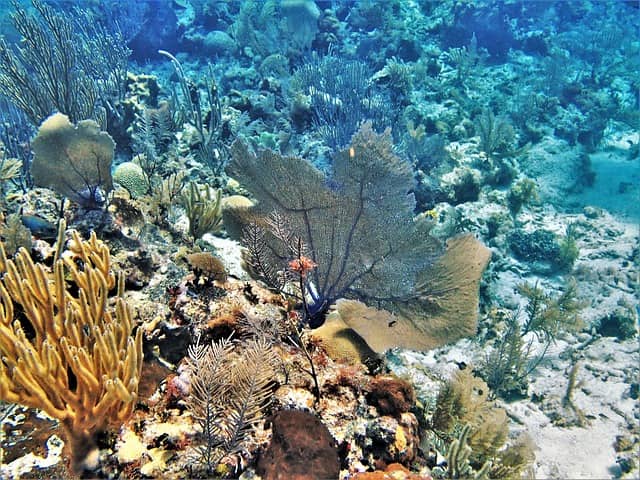Coral reefs: Reef fishes of the Caribbean Sea
There are approximately 577 species of fish in the Mexican Caribbean, from the smallest that mimic the environment and are very difficult to see, also called cryptic, to large predators.

Coral reefs are among the greatest wonders of our planet. They inhabit the tropical seas, they are great living communities where thousands of organisms coexist, in a variety of shapes and colors; each one of them fulfills an important function within the reef, this fantastic architectural creation is thanks to the architects of the sea, the corals.
According to fossil records, they appeared approximately 500 million years ago, the greatest expansion occurred in the Paleozoic era, it is estimated that at that time coral reefs occupied 5 million km2 of the seafloor. At present, reefs occupy less than 1% of the seafloor. Reefs are only distributed where tropical waters exist, therefore their location is limited by cold currents, and they are only found in a belt around the earth, at the limits of the Tropics of Cancer and Capricorn.
The second-largest barrier reef in the world
The warm waters of the Caribbean Sea provide a suitable habitat for the existence of coral reefs, where the second largest barrier reef in the world is located, with more than 1000 km long, covering the entire coast of Quintana Roo in Mexico, Belize, Guatemala, and Honduras. The dominant reefs of the Caribbean are of the coastal type, which are presented as a coral belt parallel to the coast, with a flat inner reef and platform reefs, which also follow the coastline, but their growth is considerably higher than the coastal reefs.
These formations are created by the so-called hard corals, named for their ability to manufacture a hard skeleton by extracting calcium carbonate from the water and incorporating it into their tissues. The continuous growth and accumulation of these organisms and their skeletons form large colonies and little by little these accumulations become larger and larger, thus creating the great reefs, which are colonized by different organisms belonging to many animal and plant groups.
What is a Coral?
Corals belong to the group of Cnidarians (such as anemones and jellyfish), they are invertebrate and sedentary animals most of their lives, they only move when they are larvae. These animals reproduce sexually and asexually; coral larvae are microscopic, called planulae, which seek a substrate to which to attach to form a polyp. The polyp is full of tentacles that serve to capture their food, the tentacles have specialized cells called nematocysts, which serve to inject a stinging substance, which they use as a defense or to hunt; they feed mainly on plankton.
The polyp grows and becomes a corallite, many corallites form a coral, and then large coral colonies arise, made up of different species of coral. Corals also have a very special type of symbiosis, since inside their soft tissues there is an alga called zooxanthellae (Zooxanthellae), which produces food that is exchanged with corals in exchange for shelter, so both organisms, algae, and coral, benefit from this relationship.
Reef fishes
In the Mexican Caribbean there are approximately 577 species of fish, from the smallest that mimic the environment and are very difficult to see, also called cryptic, to large predators, but what characterizes most of the species that inhabit the reef are their bright colors and varied body shapes, which are a whim of evolution over time, which gives them adaptive advantages to the environment in which they develop. All these species form complicated ecological and feeding relationships that encompass other animal and plant groups that inhabit the reef and its surroundings.
Each species exploits the resources it needs to survive and only competes with other species that occupy the same resources in the same way. Some species are very territorial, attacking anyone who approaches their home, as is the case of the damselfish; in this group of organisms, the coloration patterns are very important so that they can be identified by their own species, or to detect their enemies.
Coloration patterns
Other very common representatives in reefs are parrotfishes, organisms very varied in coloration, even in the same species, i.e., juveniles have coloration and when they reach adulthood it is completely different, this happens in several species. Other species use their body coloration patterns to confuse predators, an example is an ocellated butterflyfish (Chaetodon capistratus), which has a large ocellus near the tail that simulates an eye, which confuses predators and in turn protects it from them. Some colorations also serve as camouflage for protection or hunting strategy.
Variations in shape
The body shape of reef fishes is also very varied, but these modifications always have a function on the good development of the organism, such as feeding, protection, and reproduction, among others. For example, fish that feed on plankton have a large mouth, without teeth and with lamellae that allow them to filter the water to retain their food; however, coral eaters have specialized teeth in the form of plates to bite fragments of hard coral; carnivores generally have very sharp canine teeth and other small teeth to hold, tear or cut the meat. Some fishes have elongated snouts to catch their food in crevices or to pull worms out of hiding places, while fishes with large molars are capable of crushing shells and shells of mollusks and echinoderms (such as oysters and starfishes).
There are bottom-feeding fishes with a ventrally modified mouth to facilitate the capture of their food. Others have a flattened dorsal-ventral body, such as rays and soles, which allows them to perch and even hide on soft bottoms near reefs. There are also those that adopt such whimsical shapes as the angler fish or toadfish, which have their ventral fins modified to be able to hold on to a substrate, their body acquires shapes and colors that completely mimic their environment and the first spines of the dorsal fin are modified as a fishing rod, and sometimes as bait, with which they lure their prey close to their mouth to then suck them in and eat them.
Types of reproduction
Like shape or color, reproduction in reef fishes is very varied, some species lay eggs that adhere to a substrate. There are species that abandon the eggs once they are laid, while others stay to take care of the hatched larvae, providing shelter and food. Some very interesting species are mouthbrooders, keeping the eggs in their mouths until hatching, while others even protect the larvae inside their mouths.
Some of these reef fishes deposit their eggs by scattering them in the sediment or water column, leaving the eggs and larvae drifting, allowing the currents to move them, but also making them easy prey for predators. In some species reversible hermaphroditism occurs, where members of a species are born as a certain sex (female or male) or have both sexes, and can become either female or male depending on certain conditions, an example of which are groupers, ladies, and parakeets.
Behavioral adaptations
Reef fishes also present behavioral adaptations that allow them to survive and better adapt to their environment. For example, there are certain groups of species that, as juveniles or throughout their lives, feed on parasites that are attached to the surface of other fishes; these are called cleaner fishes, such as many members of the goby family (Gobiidae).
These fish provide a real service to other fish communities, keeping them free of parasites by obtaining easy food. Another behavioral adaptation is diurnal or nocturnal habits, as there are species that are active during the day, while others are active at night, spending most of the day sheltered inside the reefs, making them difficult to see.
A characteristic of nocturnal fishes is their large eyes that can be distinguished in their head, as an example: the squirrelfish (Holocentrus ascensionis), which can be seen during the day hovering near their shelters, this makes the dynamics of a reef change considerably between day and night and the species that we can observe during the day are not the same as those we observe at night, fascinating, isn't it?
Fish live on and inside reefs, which, as we have already mentioned, serve as permanent or temporary shelter, they feed on corals or other organisms, they use them as reproduction areas, they clean themselves of parasites, they serve as nurseries where many larvae of different fish species are sheltered or simply develop their entire life cycle there. That is why coral reefs are so important, thanks to them there is a great diversity of fish that can be found in the impressive reefs of the Mexican Caribbean.
Humans and reefs
Coral reefs with their vast diversity have undoubtedly been subject to natural disturbances since their emergence millions of years ago, and these disturbances play an important role in determining community structure and dynamics. However, anthropogenic disturbances (human-induced changes) have occurred in a very small fraction of time and are of most concern, as the diversity, frequency, and intensity of these disturbances have been increasing exponentially over the last 100 years.
A wide range of local, regional, and global stressors (climate change) including overfishing, habitat destruction, pesticides, heavy metal accumulation, nutrient overloading, sedimentation, and direct impacts from human activities, have put reefs at risk and with it all the fascinating life they harbor. And if we add to this the alterations to natural disturbances (such as cyclones), it is to be expected that they will result in much more damaging cumulative effects. The impacts caused mechanically by hurricanes or cyclones are much less lethal than the chronic mortality caused by man-made changes, but natural impacts play a crucial role in community dynamics over long time scales. Likewise, chronic anthropogenic impacts can impede the ability of reefs to recover after natural disasters.
It is accepted as a rule that adequate protection of this ecosystem will achieve, in addition to successful conservation, a healthier economy; to the benefit of the inhabitants of the coastal zone, due to the great number of environmental services that these ecosystems provide. Moreover, it is known that the diversity of fish communities is correlated with coral loss.
This means that the less coral cover there is on a reef, the lower the diversity of fish present.
Research has shown that a 10% loss of coral cover results in a 62% drop in the abundance of the species present on the reef. The death of corals affects reef communities because, in addition to being complex and highly productive systems, they provide, among other things, a structural habitat for a great diversity of organisms. In addition, these systems are considered carbon sinks or traps, so it is a priority to take efficient actions to care for these fragile ecosystems.
Written by Oscar Gabriel Ávila Morales and Omar Domínguez Domínguez. This story is from Saber Más magazine published by the Michoacán University of San Nicolás de Hidalgo
Omar Domínguez Domíngez
Ph.D. in Sciences, Full-time Research Professor "B" of the Faculty of Biology of the University (UMSNH), is a Member of the National System of Researchers level II. D. in Biology from the UMSNH; Master of Science in Management and Conservation of Biodiversity in the Tropics from the University of Seville, Spain; and Ph.D. in Sciences from the Institute of Marine Sciences and Limnology of the UNAM. His main interest is to understand and know the evolutionary processes that have generated the great diversity of existing freshwater and marine fishes.
Oscar Gabriel Avila Morales
Biologist graduated from the Faculty of Biology of the Universidad Michoacana de San Nicolas de Hidalgo. Currently, he is a student of the Institutional Master's Program in Biological Sciences, in the area of Ecology and Conservation, in the Faculty of Biology of the UMSNH. His main interest is the study of population ecology, mainly of exotic fish species, both marine and freshwater.




